Corsair Carbide 400R: Succeeding in Reverse
by Dustin Sklavos on September 3, 2011 12:30 AM EST- Posted in
- Cases/Cooling/PSUs
- Corsair
- mid-tower
Noise and Thermal Testing, Stock
Since the Corsair Carbide 400R doesn't include a fan controller, the case fans are pretty much at the mercy of ASUS's questionable motherboard fan controls. As I mentioned before, though, I opted to test the 400R both in its factory configuration and with an additional two 140mm intake fans mounted to the inside panel to see how much they would improve cooling, if at all. For the other enclosures we've previously tested that do use fan controllers, I've included their most balanced and optimal results.
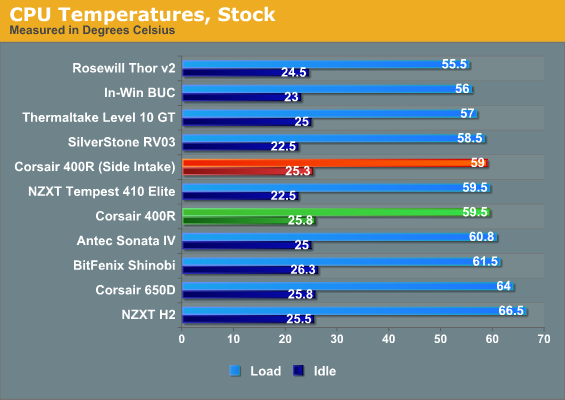

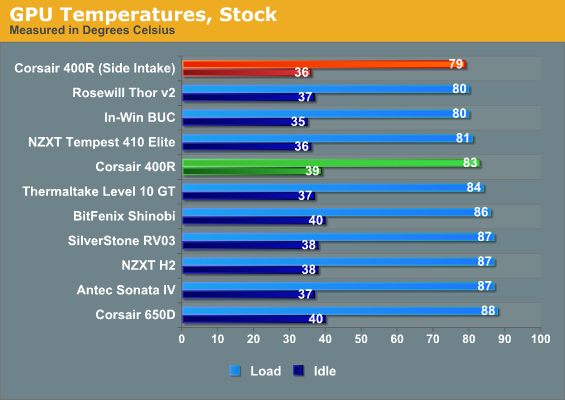
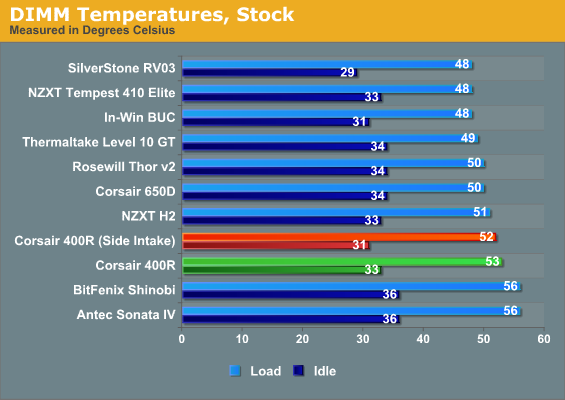
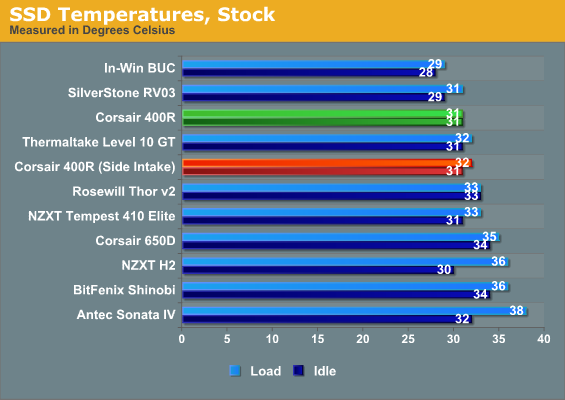
So far my theory doesn't seem to be working out so well. The improvement in cooling performance is very minor compared to just using the 400R's default fan configuration, with only the Zotac GeForce GTX 580 seeing any real improvement in thermal performance. Overall temperatures are reasonable, just not particularly exciting.
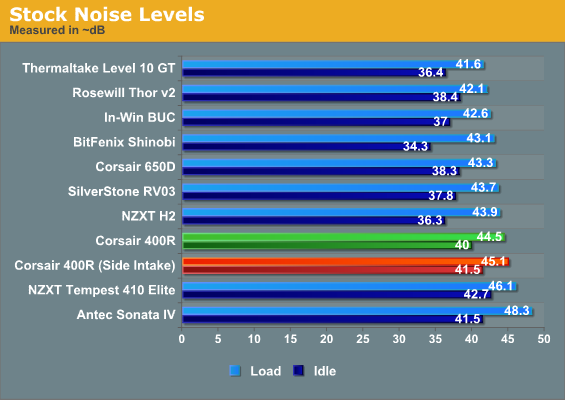
Unfortunately, noise levels aren't so great either. With or without those intake fans, the 400R is one of the loudest cases we've tested at both idle and load. Corsair switched from using a giant intake fan on the front of the enclosure to a pair of 120mm fans, and now that we're testing the 400R I have to wonder if including a fan controller wouldn't have been such a bad idea after all.










21 Comments
View All Comments
poohbear - Saturday, September 3, 2011 - link
I'm still happy with my Corsair 600T which your review actually enticed me into buying! the only gripe is that the 600T is so huge!!! people visiting me usually gasp at how big it is & ask me why i need such a big case.:p Is the 400R more in line with the average size of a common computer case? carrying the 600T to LAN parties or to a friends house was always a pain in the butt, but its no biggie as i hardly ever do that.Impulses - Saturday, September 3, 2011 - link
Outside of Silverstone's radical rotated designs, and the occasional Lian Li with the mobo mounted on the opposite side, there doesn't seem to be a whole lot of innovation going on as far as internal layouts. Why do so many cases keep trying to force air in an S shape from the bpttom front and out the back/top?Why not a more linear airflow design? The vast majority of people only have one optical drive, a few may have two or one and a media card reader, and there's certainly way more enthusiasts with one or more high powered GPU that generates more heat than their CPU...
Soooo, why not move the PSU to it's original top location so it's in line with one or two optical bays, then have a 120mm intake directly below those, in line with the fan on most tower coolers and the rear exhaust... Thus creating a direct path for airflow. Then just have a large side intake over the GPUs which usually vent out the back, could even toss in some sorta adjustable divider to separate the GPU(s) from the stuff above 'em.
It wouldn't be an ideal layout for people with tons of drives, but I don't think most people running a home server are also having the same rig serve double duty as a gaming rig. Or male a wider/shorter case where optical drives mount vertically along fan mounts (leaving plenty of room for cable management and tall coolers in the process), with hard drive mounts all along the bottom next to a bottom mounted PSU.
That's what bothers me about all these enthusiast cases, so much wasted drive bay space, it's probably not even good for air circulation. There's really a market for SFF and cases that could hold a high end rig and over a dozen drives but there isn't a market for someone that just wants optimal linear airflow for a high end rig period?
cactusdog - Saturday, September 3, 2011 - link
Because then you have a pocket of non circulating air in the bottom half of the case. The traditional method of taking air in at the bottom and out at the top has lasted so long because it works and its the most efficient.lwatcdr - Saturday, September 3, 2011 - link
The simple answer is the universe sucks.You do not want "Smooth air flow" for heat transfer, you want a turbulent airflow. If air flows smoothly you get what is called a boundary layer which is very sluggish and almost stops. It acts as an insulator. Or course it takes more power and makes more noise to have turbulent airflow.
Now the positive pressure idea is a very good one. Increasing the pressure in the case means more mass to remove the heat. Of course because the universe does suck when you pressurize a gas it gets hotter but the increase in mass flow should make up for that.
mjsunkiter - Saturday, September 3, 2011 - link
This logic in the first part of your statement is valid, involving turbulent flow.However, the second part is not so sound. Air moving at low speeds (<~0.3 Mach) is effectively incompressible, from a fluid flow standpoint. The increase in mass is negligible, the increase in pressure is effectively non-existent. The amount of heat generated by the fan motor is likely several order of magnitude higher than the increase in temperature of the air due to any compression.
superccs - Monday, September 5, 2011 - link
I agree with most of this line of thought...I have one of those wierd Lian Lis with the mobo on the left side and the PSU infront. I can get some crazy back to front air flow that keeps the main components (GPU CPU) frosty and interal temps get to around 35C under load.
What I do have are fans in specific areas of my case (on the inside) which evacuate the stagnant areas and utilize positive back to front high flow air stream. This lets my CPU and GPU get fresh air, which is then rapidly exhausted toward the front of the case. Exposing the 3-4 HDDs to a mild blast of warm air (big deal).
Who is making modular cases these days that you can replace panels with to add of delete fan mount locations?
v12v12 - Sunday, September 18, 2011 - link
Basically the traditional "PC" (non Apple) case uses the antiquated "warehouse" strategy... A big large box with many options for cooling and room for expansion. This works great for the serious hobbyist with tons of time and tools to get seriously creative. It does not work for those that do not and do not wish to invest said time and resources into a case that already is overpriced...People do you get it yet; CASES ARE OVERPRICED stamped/cut out cheap, LOW QUALITY ALLOY aluminum. It's not 6061t or 7000 aircraft grade. This stuff is the lowest grade recycled junk material; sure it works well for a case, but the PRICE does not at all reflect the quality of build/material. $100 for a box that takes no more than 20minutes to produce from start to finish on an assembly line.!??? STOP PAYING FOR JUNK AND SUPPORTING THE VENDORS OF THIS CRAP! OR... continue getting fleeced?????
What I've always done is take ideas from basic HVAC systems and apply them like Apple has to their old G4-5 towers = ZONED COOLING separation. Your ideas are right in line with said practice; U ISOLATE heat zones and have dedicated fans cooling said zones. Theres some things I should clear up about turbulence and smooth flow; you want BOTH.
Smoother flowing air EN ROUTE to the heat source(s) = faster flowing air = MORE turbulence once it strikes the intended heat source. You do NOT want turbulent air flow (slow and less controlled) before the air hits the heat sources... The speed produces the increased turbulence, which disrupts the boundary layer (this is minimal in a PC in most cases), which increases cooling efficiency.
So in a PC case, you want to speed up the air before it reaches the heat source, then speed it up again once it has hit the heat source(s) so it can quickly be exhausted. You do this by taking some card board and tape and making a mock zoned ducting system to segregate components at the top and bottom and even within those diff zones themselves... Then take said cardboard and use it as a stencil to make a better looking/stronger (etc) zone from plastic, or other more durable materials. Personally corrugated cardboard + metallic ducting tape works well enough for me... I just take some spray paint and color the cardboard+tape and leave it be... It really does work wonders! The key is getting as MUCH OUTSIDE air into/out of the case as fast as audibly tolerable.... Zoned-cooling also lowers the noise factor by many decibels too!
I hate to plug "Apple" but they are an engineering and design corp. They have a serious leg up as they can implement such technology and mandate it with out worry of issue from consumers... If a PC case maker tries and fails to sell they risk losing serious capital; Apple never worries, their user based will take it up their arse or forced spoon-fed in their maws lol. Apple's got the leg up on "PC" cases.
Malih - Saturday, September 3, 2011 - link
In my setup I install Side Intake fans and also Top Exhausts (hot air rises thingie) and a Bottom Intake (I have the a CM690 with Side Window) and they work quite well.I just thought if you want to test a case maximum cooling performance, might as well install all the fans, althought I'll admit I'm not really knowledgeable on this area. Your thoughts?
casteve - Saturday, September 3, 2011 - link
..but they significantly impede airflow causing higher temps and fan noise. Too bad the drive cage can't be removed.Khronikos - Saturday, September 3, 2011 - link
I love my 690 ll advanced. After looking at a lot of other designs for my needs I still think I made the right choice. I do like the 700D as well quite a bit. This case looks a little wonky to me. Still very decent feature list.